Salt and its Effect in Bread Baking
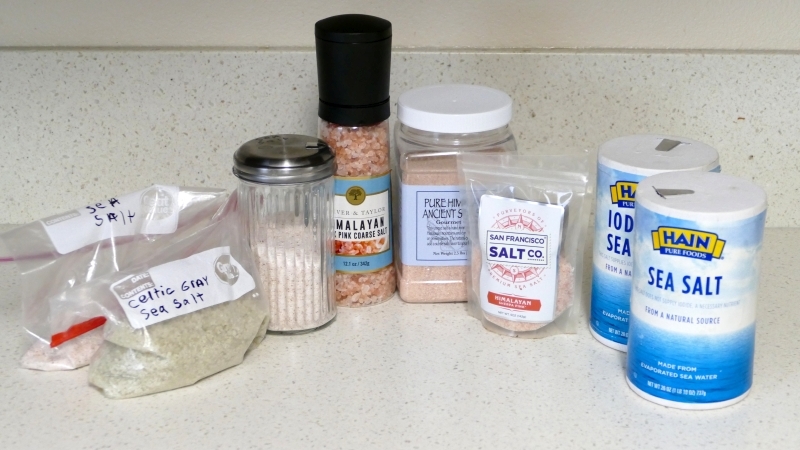

Salt is an important ingredient in bread baking. It’s a tool in the hands of savvy bakers which can be used in many ways. Once you know what salt can do, you can use it to slow down dough fermentation and retard enzymatic activity in whole grain mashes and sprouted flours. There are many effects of using salt in bread baking.
Some of the effects of salt are:
- Inhibit fermentation – slow it down
- Control overly enzymatic activity of mashes and sprouted flour dough
- Superior flavor and enhanced aroma
- Crust color
- Crumb and crust moisture – Salt is Hygroscopic and draws moisture to itself.
- Tighten and strengthen gluten
- Protects gluten from enzyme action
- Can slow down staling of bread
- Can absorb moisture in a humid environment
Salt can kill yeast if in direct contact with it. However, if added to the other ingredients during the mix it isn’t usually in contact with the yeast for long enough for it to have too much of a deleterious effect. I wouldn’t pour salt on top of the sourdough starter or yeast, but I would add it to the mixing bowl with the other ingredients, either to the water or on top of the flour.
The recommended amount of salt for bread is around 1.8 to 2% (per total flour weight). Some bakers will go as high as 2.2% salt per flour weight. You can use less salt. Some breads, notably Tuscan bread, uses no salt at all, however it’s insipid taste is modified by the salty broths and soups it is served with. You can also use salty butter when you serve it to enhance flavor. Salt-less bread stales and molds more quickly.
Salt enhances the flavor and aroma of bread. Salt will enhance flavor and aroma by slowing down the fermentation time and allowing the full flavor and aroma of the grain to shine through.
Salt acts as an anti-oxidant. It helps the flour retain the color and flavor by slowing oxidation.
Salt enhances crust color by inhibiting the action of the bacteria and yeasts which allow more sugars to be available during the bake.
Use finer ground salt so it dissolves more readily. Purchase salt that is free from chemical additives if possible.
It’s best to weigh salt as different brands have larger flakes or crystals and will measure differently if volume measurements are used.
Some salt is “saltier” than other salts. Some sea salts and Kosher salts may actually have less sodium in them because of the other minerals present or how they are processed. So if you weigh your salt correctly but feel your bread is too salty or notice the fermentation seems slower than usual, then try using less salt in your formula. Or use more salt if you notice your bread is not as flavorful and seems to stale more quickly. However in an excessively humid environment, since salt is hygroscopic (draws water to itself), it can absorb moisture and cause bread to be damp and moldy more quickly.
In warmer climates, salt can slow down excessive fermentation in whole grain dough and in levain/sourdough starters. You can add a pinch of salt to your sourdough starter or levain to slow down the fermentation during warmer weather so you don’t have to refresh your starter so often.
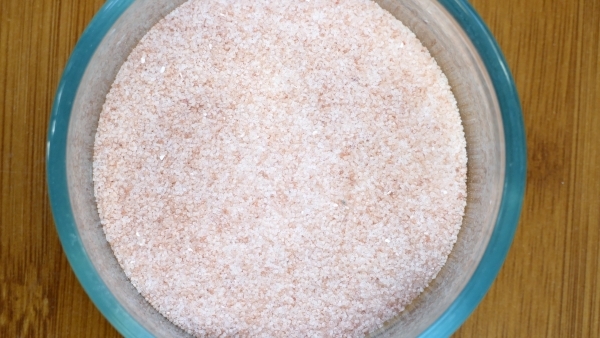
Finely ground Himalayan Pink sea salt
Salt can boost your oven spring by helping the gluten strands to be stronger and trap more gas. However, in some cases, as with a very strong flour, it can have the opposite effect as it tightens the gluten to the point where it inhibits the oven spring. In that case an autolyse, with a delay in adding the salt, will help the gluten to become more extensible. Add salt during the mixing period to help strengthen a weak dough and add salt later, after an autolyse to modify the tight gluten in a stronger dough.
Salt added during dough mixing will protect and strengthen gluten in weaker dough made from lower protein flour or in lower quality flour. If you are using a flour that seems to produce a weak dough, then skip the autolyse and add salt during the mixing period. It will slow down the degradation of the gluten and protect and strengthen the gluten instead.
Tip: Sometimes organic flour can have low protein levels or be unsuitable for bread baking (inferior quality). Some companies rely on the word “organic” to sell the flour and not the quality of the flour. If you’ve had trouble making a great loaf of bread and you’re using organic flour, try adding salt during the mix to see if it helps. Note: Some organic flours are superior and produce wonderful loaves of bread, so experiment with your flour to see how it performs. I often use Central Milling organic flours and have produced lovely loaves of bread.
Some of the off brand sea salts can contain finely ground rocks and shells (and who knows what else?). When you use this type of low quality salt you may notice crunching into a hard bit when eating the bread. To see if your salt has rocks or shells bits, put some of the salt into a strainer and wash it with warm or hot water. The salt will dissolve but you will notice hard bits left behind. Don’t use the salt if it contains rocks/shells, you can break a tooth and it’s quite annoying to run into rock bits in your bread. The salt to the left of the San Francisco salt (in the first photo of this post) had rock/shell bits in it, which made it useless for any food products.
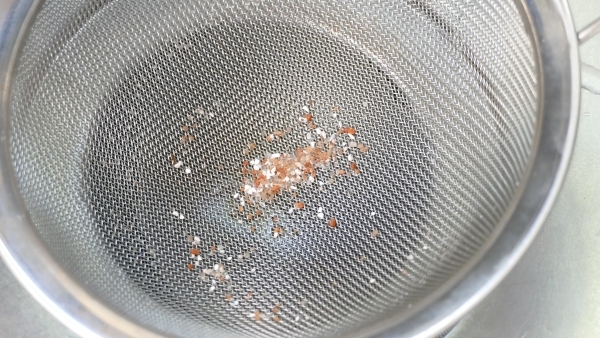
Sea salt with bits of rocks/shells in it
Sea salt can contain 70+ minerals besides sodium chloride, whereas regular table salt contains mainly one mineral and often additives as well. So the addition of sea salt will enhance the nutritional content of your bread. My all time favorite sea salts are Celtic and Himalayan sea salt although I love trying any of the unusual sea salts available from around the world. You can use a coarser ground salt by either grinding it in a salt grinder or adding your salt to your grain berries when you grind them in your grain mill (if you’ve weighed the exact amount of grain and salt that is needed for your formula).
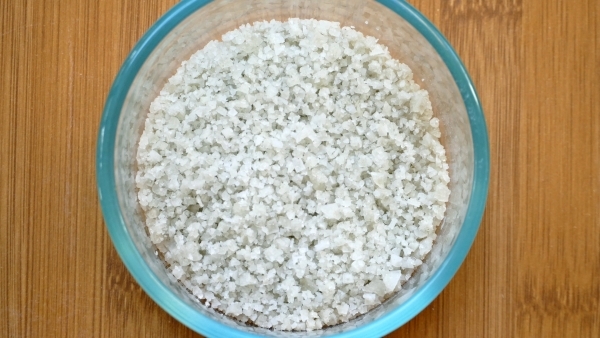
Coarse Celtic gray sea salt
So you see, salt is actually more important in bread baking than just enhancing flavor and crust color. It’s a tool when used wisely, which can help you produce superior loaves.
Further reading:
If you have any suggestions for the use of salt in bread baking, please comment below and share your knowledge with everyone.

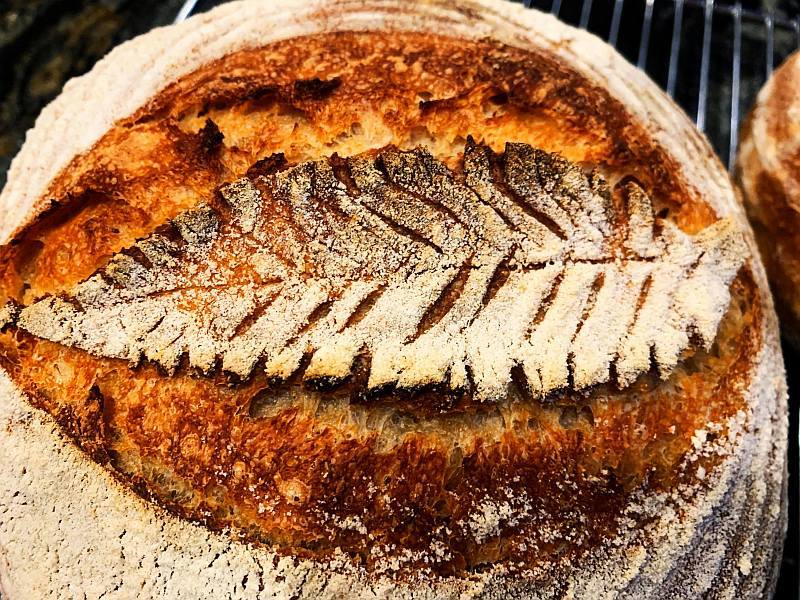
Your article was timely for me. I have been working to perfect baguettes using French flour that was milled from french grain. The flour is very weak by nature and because of this, produces baguettes with thin crackly crust and soft creamy crumb. No other flour, IMO, can duplicate french flour for an authentic baguette.
Your tip to mix the salt into the flour and water sounds excellent! It may provide a little needed strength to the dough.
Thanks for posting…
Danny
I am so happy that you found some useful information in the article Dan. Thank you for letting me know. I would love to see photos of your baguettes.
WOW, I’m a year and a half late 🙁
Didn’t see this post.
Here is a link to some of my nicer baguettes. You really don’t want to see my flops. LOL
https://www.thefreshloaf.com/node/64622/community-bake-baguettes-alfanso#comment-460837
Well worth the wait! What a great post on baguettes. Your baguettes are beautiful!